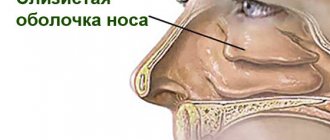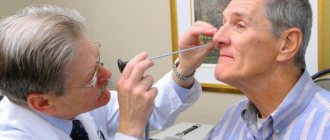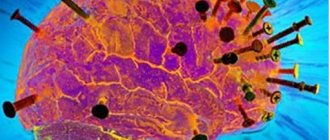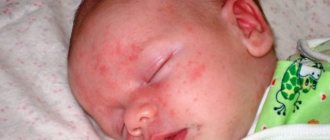Home / Papillomas
Any person suffers from certain pathologies during his life. Illnesses do not always manifest themselves in a feverish state; very often they are visible only indirectly. A striking example of such a pathology is the appearance of a growth on the body.
Neoplasms can appear in absolutely any place, for example, on the nose. In today’s article, our resource would like to tell readers specifically about nasal growths, their danger and the reasons for their appearance. Interesting? Be sure to read the material below.
Reasons for appearance
A growth on your nose? Looking for a reason
So, a growth on the nose is any neoplasm that is not genetically provided for in the human body and appears after birth. These, by the way, do not include acne, because their appearance is a completely normal phenomenon.
In any case, even a slight modification of the skin is a rather dangerous sign, as it may indicate the development of dangerous pathologies in the body (including cancer). The causes of growths can be a variety of factors.
In general, their list is as follows:
- the course of physiological processes with disruption
- infection with a virus or other infection
- lesion that provoked the development of a neoplasm
As for growths on the human nose, they do not appear so often. In most cases, they have a viral etiology associated with poor facial hygiene and the introduction of some infection deep into the skin. Other reasons for the development of neoplasms are much less common.
Types of growths
The growth on the nose has begun to change - you need to see a doctor urgently!
In addition to the reason for their appearance, growths on the human nose are divided according to their type. At the moment, dermatologists distinguish three main categories of skin tumors, namely:
- Benign growths are relatively harmless to human health. However, if they are damaged or otherwise exposed, they may begin to pose some threat.
- Malignant growths are actively developing and are always dangerous to human health. They often appear when benign tumors transform directly into malignant ones.
- Precancerous growths are more dangerous than malignant ones, but they are also quite treatable, of course, if they are identified in a timely manner. Often such neoplasms are precursors to skin cancer.
It is worth noting that each category of growths has its own subcategories, that is, subtypes of neoplasms. For general information, let's look at the main ones.
So, let's start, perhaps, with benign growths on the human nose:
- Atheroma is a skin thickening that occurs when the sebaceous gland is blocked. In appearance, it resembles a small “bump” with a specific contour. When normally present, atheroma is elastic and painlessly palpable, but when inflamed, it can cause discomfort to a person, fester and “break through.” This growth can degenerate into malignant liposarcoma, so it should not be ignored.
- Hemangioma is a tumor that forms from blood vessels or capillaries. This growth is painless, may be red or bluish in color, and can be treated. Hemangioma very rarely degenerates into a malignant tumor.
- Lymphangioma is also a tumor neoplasm that develops from the vessels of the lymphatic system. Such a growth takes a very long time to grow and appears on the nose extremely rarely, so it will not be examined in more detail. Note that lymphangioma is highly treatable.
- Wen is a growth resulting from the growth of adipose subcutaneous tissue. Externally, the neoplasm is similar to atheroma, but it never swells or hurts. The size of the wen is usually small, it is not dangerous and can be treated.
- Wart, fibroma, neurofibroma and papilloma are pronounced skin growths. The shape is often spherical or horny. Growths of this type are painless and relatively harmless to the body, but they accurately signal the presence of the papilloma virus in a person, and therefore require due attention.
- Moles are also skin formations, but with a large amount of melamine, which makes their color brown. These growths are dangerous only if they are damaged, as they often degenerate into malignant tumors.
More information about which moles are dangerous to health can be found in the video:
Now let’s turn our attention to malignant neoplasms, among which are:
- Melanomas are growths that appear from a mole. Such neoplasms are cancerous, therefore, when they first appear, they require immediate treatment.
- Basaliomas are cancerous tumors that appear in the form of unpleasant purulent wounds. The danger of these growths is similar to melanomas.
- Kaposi's sarcomas are large dark spots on the nose. They appear only in HIV-infected people in the later stages of the disease, therefore, unfortunately, they are not treated.
- Liposarcomas and fibrosarcomas are infectious lesions of adipose and skin tissues, manifesting themselves in the form of a growth. They grow slowly and are relatively harmless among malignant skin tumors, but they require proper attention from humans.
Among the precancerous growths on the nose are:
- Neoplasms in Bowen's disease, manifested as brownish plaques. They are dangerous because when they develop they develop into skin cancer.
- Xeroderma pigmentosum is a neoplasm that appears in large numbers in the form of large “ditches” during the degeneration of pigment spots. It is quite dangerous, since if inflamed or damaged, xeroderma growths can adversely affect the composition of a person’s blood.
- Senile keratoma is a skin growth often found in old people. When damaged, it bleeds profusely and is very dangerous for the body, and therefore requires proper therapy.
- A cutaneous horn is a horn-shaped formation of skin. In the final stages it can develop into cancer.
As you can see, there are quite a few types of growths on a person’s nose and they are all quite dangerous, so you should be careful about their appearance. Note that most tumors are treated, and successfully. An exception, perhaps, is Kaposi's sarcoma.
Why are they dangerous?
The danger of growths on the human nose has already been involuntarily discussed above. Summarizing the previously presented provisions, we note that:
- Benign neoplasms are dangerous due to the possibility of degeneration into malignant ones and all that follows from there.
- Malignant growths are dangerous because they can negatively affect the general condition of the body and even cause cancer.
- Precancerous skin lesions are more dangerous than malignant ones, as they are almost always harbingers of cancer.
In any case, all types of growths (with rare exceptions) can be treated, so there is no need to panic when they appear. Moreover, in such a situation, it is important to take action either by organizing treatment or maintaining preventive measures.
Localization of the lump and meaning
Based on the location of the subcutaneous lumps, initial conclusions about a possible disease can be made.
If the lump is located behind the ear, this indicates the following deviations:
- Enlarged lymph nodes. Children often suffer from infectious diseases that cause enlarged lymph nodes. Once the infection is treated, the lymph nodes will go away on their own.
- Pig or behind the ear. A disease in which a child's salivary glands become swollen. A lump forms on the cheek or earlobe. The disease threatens complications: infertility, pancreatitis. Therefore, a child diagnosed with mumps is prescribed diet and bed rest.
On the face, bumps form on the cheekbone, cheek, and nose. It is associated with acne, a skin infection. White lumps in the skin on the neck are wen, which indicates poor metabolism. Lymph nodes and subcutaneous cysts manifest themselves as lumps on the neck. Often parents discover a subcutaneous lump on the baby’s head. This is usually the result of an injury or fall. From injuries there are bumps on the head, buttocks, shins and forehead. There is nothing wrong with these formations.
One large subcutaneous pimple causes no less problems than small acne. Long ripening, pain, itching, conspicuous redness of the skin - you will learn how to get rid of these unpleasant symptoms from this article.
Causes of benign tumors of the nasal cavity
Congenital benign neoplasms of the nasal cavity are formed in the prenatal period under the influence of teratogenic factors (nicotine, alcohol, medications, etc.) on a pregnant woman.
Acquired tumors develop in the case of long-term contact of the nasal mucosa with unfavorable factors, which include:
- frequent acute and long-term chronic diseases of the nasopharynx (rhinitis, nasopharyngitis, adenoiditis, sinusitis, sinusitis and other sinusitis);
- allergic diseases of the nasal cavity (hay fever, allergic rhinitis);
- irritating chemicals (typical for people working with chemicals, pharmacists);
- air polluted by industrial gases and chemicals (typical for residents of industrial cities);
- repeated injuries to the nose;
- long-term smoking, regular drinking of alcohol.
Classification of benign tumors of the nasal cavity
Depending on the period in which the disease develops, tumors are divided into:
- congenital (teratomas, angiomas, cerebral hernias);
- acquired.
Acquired tumors according to histological classification are divided into:
- epithelial (papilloma, polyp):
- connective tissue (lymphangioma, hemangioma, neurofibroma, myxoma, schwannoma, etc.);
- growing from muscle tissue;
- growing from bone (osteoma, fibroma) and cartilage (chondroma) tissue;
- originating from lymphoid tissue;
- mixed origin (craniopharyngioma, glioma, meningioma).
Clinical symptoms of benign neoplasms of the nasal cavity
As was said at the beginning of the article, benign tumors of the nasal cavity in the early stages of their development are asymptomatic, without causing any inconvenience to the patient. Despite the patient’s good health, the tumor gradually increases in size and sooner or later begins to prevent the full flow of air into the nasopharynx - the person complains of difficulty in nasal breathing, deterioration of the sense of smell, nosebleeds, and the feeling of a foreign body in the nose. The consequence of ventilation disorders is the development of infectious agents (usually bacteria) in the nasal cavity - this entails the development of acute rhinitis, rhinopharyngitis, rhinosinusitis with their typical manifestations (headache, fever, mucous, mucopurulent or purulent nasal discharge, pain in the area of the affected sinus).
Stages of polyp development
A growth is a defect in the form of a bulge, benign or malignant, created from an epithelial cell.
Nasal polyps appear for a variety of reasons. There are several stages of occurrence:
- The initial stage is based in the upper part of the nasal septum. Does not cause significant discomfort.
- The second stage - the connective tissue expands very quickly. Most of the nasal cavity is blocked, and breathing becomes difficult.
- At the last stage, complete overlap of the passages is observed. It becomes simply impossible to breathe through your nose.
When an infection occurs on the nasal mucosa, microorganisms spread, negatively affecting the tissue. The top cell layer begins to peel off. This is expressed by nasal congestion, a burning sensation, and a change in voice. Mucus begins to be released, followed by inflammation. With timely treatment, recovery occurs within 7–10 days.
Diagnosis of benign tumors of the nasal cavity
The diagnosis is made by an otolaryngologist. Based on the patient’s complaints and medical history, he will suspect the presence of a disease of the nasal cavity, after which he will conduct a visual examination of it - rhinoscopy. During this study, a formation in the nose will be detected that has an appearance characteristic of one or another type of tumor. Sometimes neoplasms are diagnosed accidentally - when a patient visits for another, for example infectious, disease of the nasal cavity and undergoes rhinoscopy for the purpose of examination. If the origin of the tumor is doubtful, a biopsy of the formation is indicated.
If there are indications, the specialist will prescribe one or more additional examination methods:
- pharyngoscopy;
- olfactometry (determination of smell disorders);
- microscopic and cultural examination of smears taken from the throat and nasal cavity;
- radiography of the paranasal sinuses and skull;
- computed tomography of the skull and brain;
- consultation with an ophthalmologist.
Why are they dangerous?
Due to the fact that the growths are located in one of the most touchable places, there is a possibility that a person may simply accidentally pull off the tumor. This often leads to cancer, so you should be more careful.
If the wart appears in the nose, that is, in the sinus cavity, the following problems are possible:
- headache;
- nasal congestion;
- unpleasant feeling of the presence of a foreign body;
- inhalation problems;
- loss of smell.
Treatment of benign tumors of the nasal cavity
The main treatment method for tumors in this group is surgery.
The method of tumor removal directly depends on the type, growth pattern and size.
The endoscopic method using an electrocoagulating loop is used to remove small adenomas, fibroids and papillomas.
Nasal polyps are subject to excision of them and the area of the septum to which they are attached, followed by cauterization of the base of the tumor by electrocoagulation or cryotreatment.
If the transitional cell papilloma is small in size, it is removed through the nose (endonasal). If the tumor has grown into nearby tissues, it is removed using the Denver, Caldwell-Luke, and Moore approaches. If the papilloma has reached a significant size and has grown into surrounding tissues, resection (excision) of the bone structures affected by it is performed.
Large tumors are excised with a scalpel or laser beam. It is important to excise the tumor down to healthy tissue, without leaving a single pathologically altered cell (the boundaries are established under a microscope), otherwise relapses in tumor growth are possible.
Small vascular tumors are removed by electrocoagulation or using a laser. Large angiomas are removed after the carotid arteries are ligated, since during this operation there is a risk of massive bleeding. If the angioma grows deeply into the adjacent tissues, occlusion (blockage) of the vessels supplying it with blood is carried out.
Fibromas, chondromas and osteomas of small sizes are removed endonasally, while large ones are often removed in parts using external surgical access. In addition to the tumor itself, the bone structures and tissues of the face affected by it are excised, after which they resort to the use of plastic surgery.
Why do such acne appear?
Internal pimples differ from traditional acne not only in their appearance. The reasons for their appearance are also different. So, the appearance of a pimple-bump may be a consequence of hypothermia. Such inflammatory elements often occur on the buttocks and thighs.
Has a huge pimple appeared on your forehead like a bump? In this case, the reason is trivial - it is a blockage of the sebaceous duct. Such an inflammatory element takes a very long time to mature – sometimes it doesn’t take 2 weeks. The skin in this area may remain the same color as on healthy areas of the face, or it may acquire a bluish or burgundy tint.
In addition, the causes of internal acne on the body and face can be:
- decreased protective functions of the body (for example, after an illness);
- unhealthy diet with a predominance of fatty foods;
- infection entering the body (for example, through a scratch on the skin).
Causes
There are a number of factors that predispose a person to the formation of growths in the nose. A special role is played by chronic inflammatory reactions of the nasal cavity, provoking hyperplasia of the mucous membrane. This may include:
- Infectious diseases of viral or bacterial origin of the nasal cavity or paranasal sinuses.
- Allergic reactions to pollen, animal hair, dust, household chemicals.
- Previous trauma to the facial part of the skull, which resulted in a deviated nasal septum.
- Burdened hereditary history.
- Autoimmune reactions.
Papillomas
The most common type of growth in the nose. Morphologically, it is a benign neoplasm of gray, pink or red color, with a bumpy surface. The provocateur of development is the human papillomavirus, which actively multiplies in the mucosa, leading to its hyperplasia (proliferation).
The infection may not manifest itself for many years, but when the immune system is weakened, it enters an active phase of division.
Polyps
Also refer to benign formations of the mucous membrane. Visually it can look like a pea, bean, mushroom, pine cone or bunch of grapes. As a rule, they are a consequence of chronic rhinitis. It can affect not only the nasal cavity, but also the paranasal sinuses.
In the classification of polyps, there are several stages based on the size of the tumor and the degree of obstruction of the nasal cavity:
- partial overlap that does not cause breathing problems;
- a medium-sized polyp that significantly blocks the nasal passage, resulting in difficulty breathing;
- complete blockage of the nasal passage, manifested by the absence of nasal breathing.
Adenomas
They are formed from the glandular epithelium of the nasal mucosa. By its nature it is a benign neoplasm. The mechanism and causes of formation have not yet been sufficiently studied, however, there is a connection between an imbalance in hormones that regulate physiological processes in the glandular epithelium.
Vascular tumors
Compared to other nasal tumors, they are quite rare. Depending on the vessel, hemangiomas, lymphangiomas and tumors of mixed origin are distinguished.
Typical localization of growths in the nose of this type are: the septum, fornix or area at the level of the middle and lower nasal conchae. To confirm the diagnosis, it is important to conduct a histological examination of tissues.
Chondromas
Benign neoplasm of cartilage tissue. It is rare due to the fact that chondrocytes have low proliferative activity. It is located on a wide base, the shape is round, the consistency is tightly elastic.
Characterized by slow growth over several years. It can be localized in the area of the base or wings of the nose. Treatment in this case is only surgical.
Osteomas
Characterized by deep growth, accompanied by damage to the paranasal sinuses. In most cases, these neoplasms are found in the frontal, maxillary sinus and/or in the ethmoidal labyrinth.
As a rule, they grow slowly, but there have been cases of rapid growth, when the tumor increased in size by 3–4 times within two years, completely blocking the nasal passage.
Medical indications
White bumps on the skin can appear on any part of the body: face, arms, legs, back. Benign formation in the initial stages goes unnoticed. There is no pain, and the formation grows slowly. The patient notices it when the formation becomes large.
If the lump under the skin shows signs of local inflammation, then pain and discomfort are felt, the local temperature rises, and the skin becomes redder. Additional disorders are also observed: weakness, general malaise, headache. These neoplasms arise against the background of infection. You can get rid of them if you undergo competent and timely treatment.
Lumps under the skin can be malignant growths, which are less common. They can be identified independently by external signs. In such cases, urgent medical attention is required. Often, nodules on the skin are a wen, which is harmless and arises from adipose tissue. This soft neoplasm has clear boundaries. Sometimes its surface may be bumpy. At the same time, the skin does not suffer any changes, maintaining its color and density. In this case, you can assemble the fold.
The usual place for the spine to form is on the hairy parts of the body. If the lipoma reaches a large size, it puts pressure on neighboring organs or muscles, which causes pain. Wen is often called atheroma. But atheroma is a cyst or sebaceous gland in a stretched state, which has a blocked excretory duct. Over time, the gland stretches.
On palpation, a dense round formation with clear boundaries is felt. Skin fused with atheroma does not fold. It changes color, and in the middle you can see a dot - this is a clogged duct. Inflammation or suppuration may occur. The main treatment for atheroma is surgical removal.
Symptoms
Prolonged inflammation of the nasal mucosa for more than 3 months contributes to the formation of growths. The most common clinical manifestation of this condition is persistent nasal obstruction.
There are several more symptoms:
- Problems with nasal breathing. It is caused by a pronounced increase in the volume of the mucous membrane, partially or completely covering the nasal cavity.
- Nasal discharge that is white or green in color. The symptom indicates the addition of a secondary infection, which provokes excessive mucus production.
- Sneezing. On the surface of the nasal epithelium there are special sensitive receptors that perform a protective reaction when ingested by large amounts of pollen, dust or other fine particles. In the presence of growths in the nose, excessive irritation of these receptors occurs, which is accompanied by the act of sneezing.
- Complete or partial anosmia. In this situation, this term implies a violation of the sense of smell resulting from a decrease in the number of olfactory receptors.
- Due to the reduction of the nasal cavity, an increase in intracranial pressure is observed, which is expressed in the form of a headache.
- Nasal voice.
Helping the maturation of subcutaneous pimples
Most often, it is those with oily skin who are prone to acne.
, but internal pimple is very insidious and appears on any skin type.
When a red bump has formed on the body, pressure on which is accompanied by painful sensations, this is a pimple bump. Most often, acne is a consequence of hormonal imbalance or a cold.
How does a pimple bump develop?
Many microorganisms live quite quietly on the surface of the epidermis. Various factors (hormonal, disruption, stress and much more) turn bacteria into harmful pests that penetrate the ducts of the sebaceous glands, where they multiply at an accelerated rate. As a result, the lump increases and causes additional discomfort and pain.
Treatment of a subcutaneous formation is complicated by the fact that it matures, but cannot break through.
Squeezing out the formation is prohibited, as the infection will spread to adjacent tissues and the result will be scars on the skin.
Treatment
If the cause of nasal breathing disturbance is a polyp, then first you can try more conservative treatment methods, including the use of antihistamines and nasal glucocorticoids. If a secondary microbial infection occurs, antibiotics must be prescribed.
Surgical intervention is used in the presence of malignant neoplasms, as well as benign ones that have a tendency to become malignant.
Minimally invasive endoscopic operations are now in greatest demand. This type of surgical procedure involves the introduction of a small camera into the nasal cavity, with the help of which it is possible to obtain a high-quality image of the tumor. At the same time, instruments are inserted into the nose to remove the growth. The procedure is practically painless, low-traumatic and does not require subsequent hospitalization.
In adults
As a rule, adults seek help in the later stages, when the tumor is already pronounced and almost completely covers the nasal cavity. The extent of surgical intervention depends on the nature of the tumor. In addition to surgical treatment, additional radiation and chemotherapy may be necessary.
In children
Treatment of growths in the nose in a child is best started conservatively with the use of medications. If this does not help, then small growths can be effectively removed with a laser. It can also be used to remove intranasal warts. The procedure is performed on an outpatient basis and takes no more than an hour.
How to get rid of it?
You can eliminate a pimple in the form of a lump using more humane methods:
- Seek help from a cosmetologist. In his arsenal there are many methods for treating subcutaneous inflammatory elements. If the pimple is “ripe,” the cosmetologist will squeeze it out under sterile conditions using special instruments. If not, you can try to speed up the resorption process, for example, using the Darsonval apparatus.
- Make homemade masks and bandages. To make the abscess resolve faster, apply a bandage with honey to the skin several times. Aloe juice draws out pus well. Apply the pulp of the plant to the pine cone and secure with a bandage. You can leave the bandage on overnight - there will be no harm.
- Cure with pharmaceutical drugs. In the pharmacy you will find a lot of inexpensive medicines that are used just to draw out the contents of ulcers. These include Vishnevsky ointment, famous since Soviet times, ichthyol ointment, “Levomekol” and others. You can buy a ready-made wound-healing dressing, for example, Branolind N, soaked in Peruvian balsam, or a chitosan dressing, Chitopran. They will speed up the removal of pus and promote faster healing of the skin. You can dry a pimple by treating it with calendula tincture, manganese solution or iodine. After 2-3 procedures it should begin to decrease in size.
- Change your skin care routine. Stop using foundation for a while to avoid clogging your pores even more. Thoroughly cleanse your skin in the morning and evening, and wipe it with special cosmetic wet wipes throughout the day to prevent dirt from getting into the pores.
- Cleanse the body from the inside. Since the appearance of subcutaneous pimples is often caused by poor nutrition, it makes sense to change your diet at least temporarily. Take a course of probiotics or brewer's yeast, eat more foods rich in fiber.
Ball-shaped lumps under the skin are common formations that can appear as lumps, tumors, or lumps. The formations in question do not pose a health threat.
- Show all
Prevention
Prevention of mucosal hyperplasia involves preventing the development of chronic infections, combating allergic reactions and preventing contact with aggressive atmospheric pollutants.
Detection of any growth in the nose or significant difficulty in nasal breathing should be a reason to immediately consult a doctor. Even benign formations often have a tendency to become malignant, and the sooner the nature of the growth is determined and treatment is started, the greater the chance of avoiding serious consequences.
Author: Bogdan Bakshun, doctor, especially for Moylor.ru
Recipes for subcutaneous acne at home
Subcutaneous acne is very painful; home recipes will help treat them:
Steam baths
- chamomile;
- calendula;
- celandine;
- mint.
The herbs are poured with boiling water, then the face is placed in front of the container, and the head is covered with a towel. This procedure will help cleanse the pores, relieve inflammation in the deepest layers of the skin and prevent the formation of new inflammations.
Herbal decoctions and lotions will help eliminate subcutaneous acne at home. Tea tree oil is added to the decoctions. It is a strong natural antibiotic
, destroying infection even in the deepest layers of the skin.
Masks for subcutaneous acne
- With calendula
- blue clay - 15 grams;
- milk - 50 ml;
- alcoholic infusion of calendula - 10 ml;
- lemon juice -5 ml.
Mix all the ingredients and apply to the face, leave for 15 minutes.
- Yeast mask
- dry yeast - 10 grams;
- milk - 50 grams;
- honey - 10 ml;
- starch - 20 grams.
Warm milk is poured into the yeast and left until it swells completely. The next step is to add liquid honey and a little starch. 10 minutes is enough, after which the mask can be washed off.
Homemade masks will help get rid of subcutaneous acne on any part of the body, including the chin.










